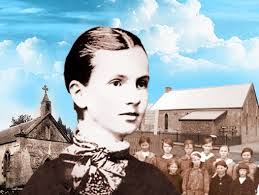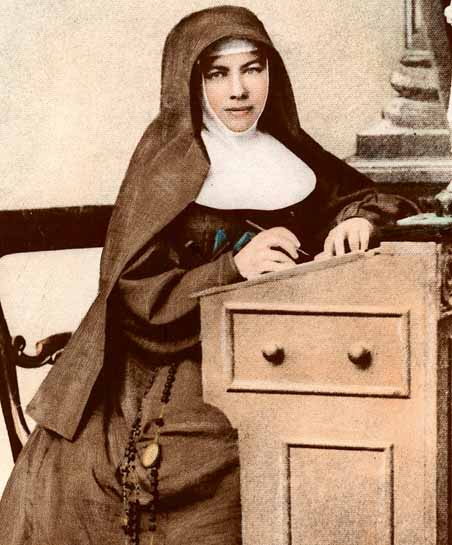
Summary: St Mary MacKillop. There was great rejoicing both in Scotland and Australia on 17th October 2010 at the canonisation in Rome of this first Australian saint. She was the daughter of Scottish migrants to Australia.
Patrick Duffy profiles her strong and persevering personality, especially her love for the poor and her ability to stand up to bullying bishops.
Daughter of Scottish immigrants
 Mary Helen MacKillop was born, the eldest of eight children to Scottish immigrants in Fitzroy, Victoria, Melbourne, on 15 January 1842. When baptised six weeks later she received the names Maria Ellen. Her parents had left Roy Bridge and Spean Bridge in Inverness-shire in the Scottish Highlands a few years earlier.
Mary Helen MacKillop was born, the eldest of eight children to Scottish immigrants in Fitzroy, Victoria, Melbourne, on 15 January 1842. When baptised six weeks later she received the names Maria Ellen. Her parents had left Roy Bridge and Spean Bridge in Inverness-shire in the Scottish Highlands a few years earlier.
Family and education
Her father, Alexander, had studied in Rome for the Catholic priesthood but, at the age of 29, left just before his ordination. He decided to migrate to Australia and arrived in Sydney in 1838. Her mother Flora MacDonald left Scotland and arrived in Melbourne in 1840. They were married in Melbourne on 14 July 1840 and eventually had seven children. Mary was well educated by her mother. Her brother Donald became a Jesuit priest and worked among the aborigines in the Northern Territory and her sister Lexie became a nun. Mary received her first communion at the unusually early age of nine.

Mary and her siblings
Early responsibility
In 1851, Alexander mortgaged his farm and made a trip to Scotland lasting some 17 months. Though a loving father and husband, he was often unemployed, so Mary had to take on responsibility early in life. She started work at the age of 14 as a clerk in Melbourne and later as a teacher and as a governess at her aunt and uncle’s place at Penola in Adelaide, South Australia. She looked after their children and taught them and included the other children as well.
Founding of school and religious order
While teaching at Portland, a Father Julian Woods invited Mary and her sisters Annie and Lexie to come to Penola and open a Catholic school there. In 1866, the school was opened in a stable and after renovations by their brother, the MacKillops started teaching more than fifty children. In the same year, at age 25, Mary put on a simple black habit and took the religious name Sister Mary of the Cross.
Sisters of St Joseph of the Sacred Heart
In 1867, Mary took vows in the newly formed order of the Sisters of St Joseph of the Sacred Heart and moved to the new convent in Grote Street, Adelaide, where they founded a new school at the request of Bishop Laurence Sheil. Other young women came to join the first religious order to be founded by an Australian.
Controversy over the rule
Father Woods and Mary wrote the rule. The emphasis was on poverty, dependence on divine providence, and faith that God would provide. The sisters were to go wherever they were needed. The rules were approved by Bishop Sheil of Adelaide. By the end of 1867, ten other sisters had joined the Josephites. They cared for the needy regardless of religion, race or social status.
 Resisting control by the bishops
Resisting control by the bishops
The bishops in Australia felt that the new congregation should be under the control of the local bishop in each diocese, but Mary wanted a congregation that would be centrally controlled so that the local bishop would not have a say in the day to day running or in the appointments of sisters. Difference over this led to Mary herself being ‘excommunicated‘ by Bishop Sheil of Adelaide for insubordination and disobedience. Mary took it all with patience and good humour. Five months later, shortly before he died, the bishop admitted that he had been badly advised and lifted the ‘excommunication‘.
Papal approval: To Rome, Scotland and Ireland
Mary realised that only papal approval would give her the independence she wanted. She headed off for Rome in 1873 and explained her case to Rome. She eventually got approval for her Constitutions from Pope Leo XIII in 1888. Mary took the opportunity of the trip to Europe to visit Scotland for three months and then Ireland, where she recruited fifteen young Irish women wanting to enter the congregation.
Return from Rome
When she returned from Rome in January 1875, Mary still had to deal with episcopal opposition, but she was unanimously elected as Superior General of the order in 1875. She served in this position until removed by the Bishop of Sydney, Francis Patrick Moran. Despite all the trouble, the order expanded. By 1877, it operated more than 40 schools in and around Adelaide, with many others in Queensland and New South Wales. After the appointment of Archbishop Roger Vaughan of Sydney in 1877 life became a little easier for Mary and her Sisters. But the opposition of bishops continued.
Brown and black Josephites
When Mary’s Constitutions for her order were approved, sisters who did not favour the central model of government could remain Sisters of St Joseph attached to a particular diocese under the authority of the local bishop. The centrally governed group were called the “brown Josephites” and the diocesan groups were the “black Josephites”.
New Zealand
However, Bishop Reynolds of Adelaide relieved Mary of her post and she went for a while to New Zealand. But in 1899 she was re-elected unopposed as Mother Superior-General, a position she held until her own death.

Australia’s first saint, St Mary MacKillop
Health problems
During the later years of her life Mary had many problems as her health deteriorated. She suffered from rheumatism and after a stroke in New Zealand in 1902, became paralysed on her right side. For seven years, she had to rely on a wheelchair to move around, but her speech and mental powers remained as good as ever. Even after suffering the stroke, the Sisters had enough confidence in her to re-elect her in 1905.
Death and canonisation
Mother Mary MacKillop died on 8th August 1909 in the Josephite convent in North Sydney. She was beatified in 1995 and was canonised on 17th October 2010.
*************************
Memorable quote for today
‘Never see a need without trying to do something about it.’
~ Mary Mac Killop ~
*************************